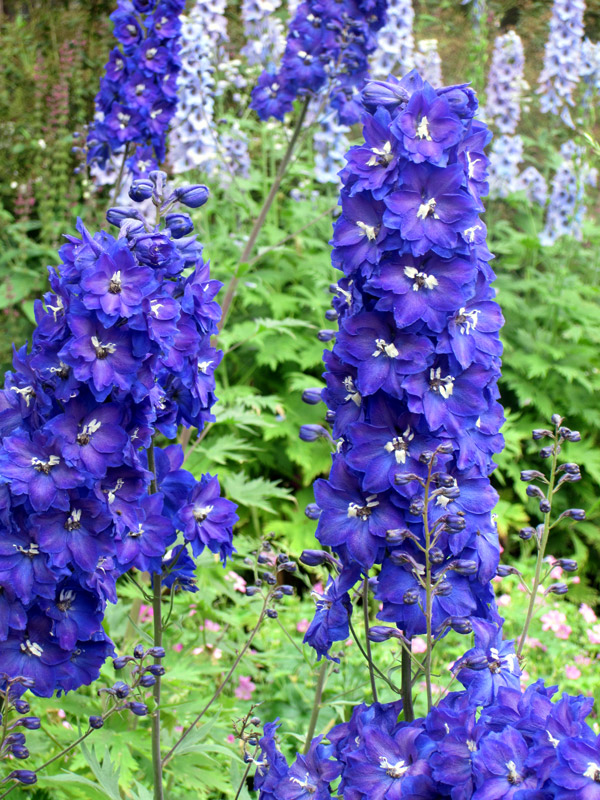

Giant Larkspur Blauw Boeket Seeds - Annual Delphinium
Giant Larkspur Blauw Boeket Seeds - Annual Delphinium
Delphinium ajacis Blauw Boeket
Giant Larkspur, Rocket Larkspur, Doubtful knight's-spur
Special offer!
Receive a €20 voucher for any order over €90 (excluding delivery costs, credit notes, and plastic-free options)!
1- Add your favorite plants to your cart.
2- Once you have reached €90, confirm your order (you can even choose the delivery date!).
3- As soon as your order is shipped, you will receive an email containing your voucher code, valid for 3 months (90 days).
Your voucher is unique and can only be used once, for any order with a minimum value of €20, excluding delivery costs.
Can be combined with other current offers, non-divisible and non-refundable.
Home or relay delivery (depending on size and destination)
Schedule delivery date,
and select date in basket
This plant carries a 6 months recovery warranty
More information
We guarantee the quality of our plants for a full growing cycle, and will replace at our expense any plant that fails to recover under normal climatic and planting conditions.
Would this plant suit my garden?
Set up your Plantfit profile →
Description
Giant Larskpur 'Blauw Boeket' boasts numerous spikes of single or semi-double flowers in a lovely array of blue shades. The 1.20 m tall plants are well-branched. Annual delphiniums are hardy, easy-to-grow plants that are popular for cutting. The tall flower spikes stand out at the back of summer beds and borders, gorgeous in front of lower-growing perennials. Direct sow in spring in rich, cool soil, in a sunny, sheltered position.
Delphinium 'Blauw Boeket' is one of the many hybrids selected from Field Larkspur (D. consolida), a winter-germinating annual that occurs naturally in sandy or chalky cornfields. Annual delphiniums are hardy, fast-growing plants that form a wide 35-40 cm clump. The leaves are palmately divided or lobed, soft green in colour, topped with 120 cm tall floral stems in summer. From June to September, single or semi-double cup-shaped blooms appear, densely gathered on tall, erect spires. The display a wide array of harmonious blue shades including dark blue, sky blue, pale blue and greyish-white, sometimes highlighted with a touch of white. They are a magnet to foraging insects.
The characteristic silhouette of Delphiniums always brings an elegant fullness, verticality and charm to perennial beds. For a romantic touch, combine them with old roses and Baby's Breath. The long-lasting blooms are particularly suitable for cutting. For dried flower arrangements, hang small bouquets upside down in a dry, well-ventilated place, away from direct sunlight.
Flowering
Foliage
Plant habit
Safety measures
Botanical data
Delphinium
ajacis
Blauw Boeket
Ranunculaceae
Giant Larkspur, Rocket Larkspur, Doubtful knight's-spur
Cultivar or hybrid
ingestion
Cette plante est toxique si elle est ingérée volontairement ou involontairement.
Ne la plantez pas là où de jeunes enfants peuvent évoluer, et lavez-vous les mains après l'avoir manipulée.
Pensez à conserver l'étiquette de la plante, à la photographier ou à noter son nom, afin de faciliter le travail des professionnels de santé.
Davantage d'informations sur https://plantes-risque.info
Other Delphinium seeds
View all →Planting and care
Sow the seeds of Delphinium Blauw Boeket directly outside, from April to May, in full sun, on a fertile, light, well-drained soil, previously well-prepared.
Bury the fine seeds at a depth of 6mm in small holes spaced 30cm apart. Keep the soil moist by watering regularly, especially during dry periods. Germination usually takes 14 to 21 days. When the seedlings are large enough to handle, thin them by planting only one plant every 15cm.
For earlier flowering, sow the Delphinium seeds from August to October in 7.5cm pots with quality compost kept moist. Place the pots in a mini-greenhouse or inside a plastic bag at a temperature of 15-20°C until germination. Once the seedlings have developed, place them in a bright, but cooler location. Overwinter the plants in a cool, bright place, protected from frost, by watering them sparingly. Transplant them to their final location in the following spring.
Water regularly until the plants are fully established. Insert sturdy stakes among the tall plants by 10cm, which will allow them to rise while being supported. You can also stake the plants with bamboo canes. Regularly remove faded flowers to encourage the renewal of flowering. Delphiniums appreciate sunny locations, protected from the wind, as well as fertile soil, rich in organic matter and well-drained.
Sowing period
Intended location
Planting & care advice
This item has not been reviewed yet - be the first to leave a review about it.
Similar products
Haven't found what you were looking for?
Hardiness is the lowest winter temperature a plant can endure without suffering serious damage or even dying. However, hardiness is affected by location (a sheltered area, such as a patio), protection (winter cover) and soil type (hardiness is improved by well-drained soil).

Photo Sharing Terms & Conditions
In order to encourage gardeners to interact and share their experiences, Promesse de fleurs offers various media enabling content to be uploaded onto its Site - in particular via the ‘Photo sharing’ module.
The User agrees to refrain from:
- Posting any content that is illegal, prejudicial, insulting, racist, inciteful to hatred, revisionist, contrary to public decency, that infringes on privacy or on the privacy rights of third parties, in particular the publicity rights of persons and goods, intellectual property rights, or the right to privacy.
- Submitting content on behalf of a third party;
- Impersonate the identity of a third party and/or publish any personal information about a third party;
In general, the User undertakes to refrain from any unethical behaviour.
All Content (in particular text, comments, files, images, photos, videos, creative works, etc.), which may be subject to property or intellectual property rights, image or other private rights, shall remain the property of the User, subject to the limited rights granted by the terms of the licence granted by Promesse de fleurs as stated below. Users are at liberty to publish or not to publish such Content on the Site, notably via the ‘Photo Sharing’ facility, and accept that this Content shall be made public and freely accessible, notably on the Internet.
Users further acknowledge, undertake to have ,and guarantee that they hold all necessary rights and permissions to publish such material on the Site, in particular with regard to the legislation in force pertaining to any privacy, property, intellectual property, image, or contractual rights, or rights of any other nature. By publishing such Content on the Site, Users acknowledge accepting full liability as publishers of the Content within the meaning of the law, and grant Promesse de fleurs, free of charge, an inclusive, worldwide licence for the said Content for the entire duration of its publication, including all reproduction, representation, up/downloading, displaying, performing, transmission, and storage rights.
Users also grant permission for their name to be linked to the Content and accept that this link may not always be made available.
By engaging in posting material, Users consent to their Content becoming automatically accessible on the Internet, in particular on other sites and/or blogs and/or web pages of the Promesse de fleurs site, including in particular social pages and the Promesse de fleurs catalogue.
Users may secure the removal of entrusted content free of charge by issuing a simple request via our contact form.
The flowering period indicated on our website applies to countries and regions located in USDA zone 8 (France, the United Kingdom, Ireland, the Netherlands, etc.)
It will vary according to where you live:
- In zones 9 to 10 (Italy, Spain, Greece, etc.), flowering will occur about 2 to 4 weeks earlier.
- In zones 6 to 7 (Germany, Poland, Slovenia, and lower mountainous regions), flowering will be delayed by 2 to 3 weeks.
- In zone 5 (Central Europe, Scandinavia), blooming will be delayed by 3 to 5 weeks.
In temperate climates, pruning of spring-flowering shrubs (forsythia, spireas, etc.) should be done just after flowering.
Pruning of summer-flowering shrubs (Indian Lilac, Perovskia, etc.) can be done in winter or spring.
In cold regions as well as with frost-sensitive plants, avoid pruning too early when severe frosts may still occur.
The planting period indicated on our website applies to countries and regions located in USDA zone 8 (France, United Kingdom, Ireland, Netherlands).
It will vary according to where you live:
- In Mediterranean zones (Marseille, Madrid, Milan, etc.), autumn and winter are the best planting periods.
- In continental zones (Strasbourg, Munich, Vienna, etc.), delay planting by 2 to 3 weeks in spring and bring it forward by 2 to 4 weeks in autumn.
- In mountainous regions (the Alps, Pyrenees, Carpathians, etc.), it is best to plant in late spring (May-June) or late summer (August-September).
The harvesting period indicated on our website applies to countries and regions in USDA zone 8 (France, England, Ireland, the Netherlands).
In colder areas (Scandinavia, Poland, Austria...) fruit and vegetable harvests are likely to be delayed by 3-4 weeks.
In warmer areas (Italy, Spain, Greece, etc.), harvesting will probably take place earlier, depending on weather conditions.
The sowing periods indicated on our website apply to countries and regions within USDA Zone 8 (France, UK, Ireland, Netherlands).
In colder areas (Scandinavia, Poland, Austria...), delay any outdoor sowing by 3-4 weeks, or sow under glass.
In warmer climes (Italy, Spain, Greece, etc.), bring outdoor sowing forward by a few weeks.




























































